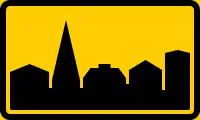Urban areas in Finland
An urban area in Finland is defined as a cluster of dwellings with at least 200 inhabitants.[1] The Finnish term for this is a taajama (Swedish: tätort). Because of the strict definition of a taajama, these areas exist both inside and outside of city and municipal borders.

The largest taajama in Finland is the Helsinki urban area with over 1.3 million inhabitants in 2019.[2] It extends across Helsinki as well as ten other municipalities in the Greater Helsinki area. The second largest is the Tampere urban area with about 342,000 inhabitants in 2019,[2] and the third largest is the Turku urban area with about 278,000 inhabitants in 2019.[2]
The presence of taajama areas is used to regulate traffic, with a default of 50 kilometres per hour (31 mph) speed limit inside a taajama and 80 kilometres per hour (50 mph) outside. Each major road leading in or out of a taajama is marked with a road sign.
See also
References
- "Locality | Concepts | Statistics Finland". stat.fi. Statistics Finland. Retrieved 2021-03-14.
- "Taajamat väkiluvun ja väestöntiheyden mukaan, 2019". stat.fi. Statistics Finland. Retrieved 2021-03-11.

